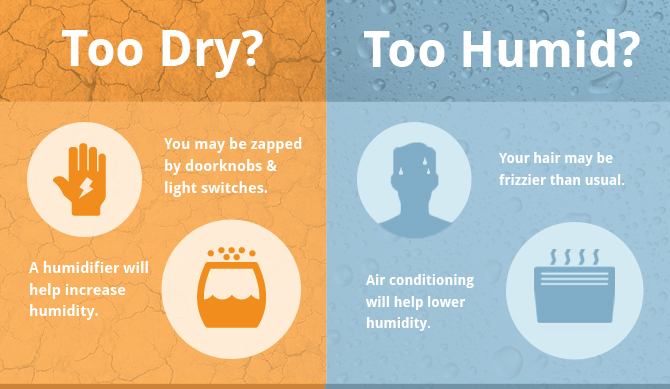
Staying comfortable in your home means more than just adjusting the thermostat. Humidity plays an important part when it comes to how comfortable you feel, and therefore how often you’re running your heating and cooling systems. Ideal humidity levels can also help stop the spread of common viruses and bacteria while keeping allergies in check. Here are some tips on how you can keep your home’s humidity at the optimal level to achieve a more comfortable and efficient home.
What is Humidity?
Humidity refers to how much moisture is in the air. It might be difficult for you to detect humidity in the air, but it’s easy to see its effects throughout the home. For example, you can see humidity entering the air above a boiling pot of water or see it condense on your mirror after a hot shower. You might also notice low humidity in the home when your skin is dry and itchy or if you get a lot of static shocks.
How Does Humidity Affect Your Home?
Warm air loves to hang on to humidity, and if there’s enough of it in the air, your sweat won’t evaporate from your skin. This is why you feel sweaty and sticky when it’s too humid – even if the temperatures aren’t extreme. Too much humidity can have you running the air conditioner more frequently to try to get comfortable.

Cold air, on the other hand, doesn’t hold as much humidity. If you’re trying to keep your home warm, low humidity will have you bumping up the thermostat trying to stop shivering which means the furnace runs more frequently while running up your bills.
Dust mites and mold also feel right at home in humid air while creating miserable conditions for allergy sufferers. When humidity levels drop below 60% these irritants start to die off. On the other hand, when humidity levels drop below 40%, allergens in the home are more likely to become airborne. Anything under 30% starts to create a favorable environment for viruses and bacteria to thrive.
How to Improve Humidity Levels
According to the EPA, optimal humidity levels in the summer are under 60% and between 25 and 40% in the winter. Installing a hygrometer or a thermostat with a humidity sensor will help you keep tabs on the levels in your home. Since heating costs account for 34% of all utility usage in the U.S., we’ll start with tips for staying comfortable in the winter.
During Winter
- If you’re considering an overhaul of your heating and cooling system, a whole-home humidifier can add humidity through your ducts to the entire house.
- For a simpler solution, individual room humidifiers let you keep each room just the way you like it.
- Want to go low-tech? Try placing a pan of water on a wood stove or near radiators to let the water evaporate into the air at the source.
During Summer
In the summer, the easiest way to remove humidity in the air is to run the air conditioner or use a dehumidifier. Of course, that eats up energy, too. Here are some ways to keep humidity levels low when it’s hot.
- Use fans to help keep air moving. This will help keep air slightly cooler while helping you feel more comfortable at higher temps and humidity levels.
- Ventilate, ventilate, ventilate. Always make sure to run exhaust fans in the bathroom during baths and showers and in the kitchen while you’re cooking to vent excess steam.
- If you have a lot of houseplants, move a few outdoors for the season. One or two might not have a huge effect, but a dozen in one room is enough to affect humidity levels.
Comfort at the Right Price
To learn more about how to optimize humidity levels in your home, or to find more tips for maximizing your energy budget, contact the savings specialists at Wattson Home Solutions today.







